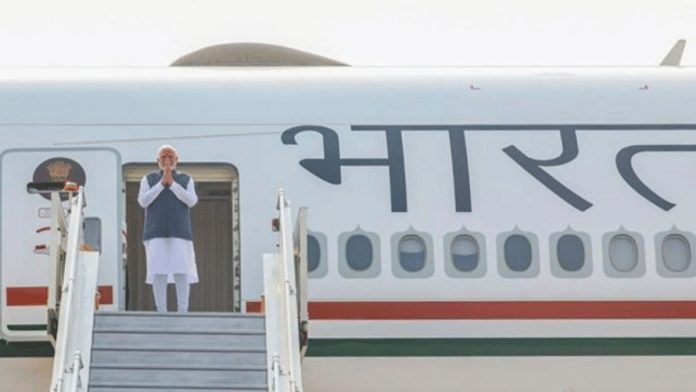New Delhi: Deepening the India-Japan defence collaboration, including co-development of an advanced system to improve naval stealth capabilities, are expected to be a part of the agenda, as Prime Minister Narendra Modi travels to Tokyo for the annual bilateral summit this week.
“This [defence ties with Japan] has indeed emerged as an important pillar of cooperation between the two countries in recent years. There was a meeting between the defense ministers that was held just recently in May, where the two sides were able to review a whole host of issues, operational engagements between the two sides, but more importantly, defense equipment and technology collaboration, which is an important part of the overall defence and security engagement,” Foreign Secretary Vikram Misri said at a special briefing Tuesday.
The Indian Navy and the Japanese Maritime Self-Defense Force are also exploring possible cooperation in the area of ship maintenance in India, he added. “And, there are discussions going on on a number of other issues between the designated agencies of the two sides, DRDO in India and ATLA in Japan.”
Like the Defence Research and Development (DRDO), the Acquisition, Technology & Logistics Agency (ATLA) is responsible for managing the acquisition of defense equipment, promoting technological development, and fostering R&D for the Japanese forces. Both the DRDO and the ATLA function under their ministries of defence.
PM Modi will be departing from New Delhi on the evening of 28 August for Tokyo. The visit will begin on 29 August and end a day later. Subsequently, Modi will depart for China to attend the Shanghai Cooperation Organisation (SCO) summit on 31 August and 1 September.
India is seeking a strong condemnation regarding terrorism as a part of the final declaration of the Heads of State summit of the SCO, said Tanmay Lal, Secretary (West) in the Ministry of External Affairs (MEA), at the special media briefing.
Also Read: Defence the cornerstone of India-Philippines strategic partnership as both nations take aim at China
India-Japan summit
Misri highlighted that a number of initiatives are set to be launched during Modi’s two-day visit to the country. Apart from the annual summit, Modi will also be interacting with Japanese Prime Minister Shigeru Ishiba outside of Tokyo. This is the first stand-alone bilateral visit for Modi to Japan since 2018.
“The programme also includes interactions of the PM with several other political leaders from Japan, as also with friends of India in Japan. The PM will also participate in a business leaders forum with captains of Japanese and Indian industry. These interactions are aimed at deepening the very important trade, investment and technology relationship between the two countries,” Misri said.
In November 2024, India and Japan signed a “memorandum of implementation” for the co-development of UNICORN masts for use by the Indian Navy. The Unified Complex Radio Antenna (UNICORN) is set to aid in the stealth capabilities of naval platforms.
Similarly, New Delhi and Tokyo have indicated interest in specific platforms during the May meeting between the two defence ministers, said Misri, without giving further details.
Furthermore, India and Japan are looking to broaden their economic engagement, with Tokyo set to unveil a number of measures, according to local media reports.
The two leaders are also set to discuss the Quad, a strategic group comprising Australia, India, Japan, and the US, due to the “high value” attached to the forum by New Delhi and Tokyo. From critical minerals to peace and security across the Indo-Pacific, the Quad has streamlined its agenda this year.
However, there is no clarification on the date of the Leaders’ Summit, which may see American President Donald Trump travel to India. Ties between India and the US have hit a rough patch, with Trump imposing tariffs of 50 percent on New Delhi.
China itinerary
Modi’s first visit to China since the 2018 SCO summit, is set to occur amidst a growing thaw in ties in the recent weeks. The leaders of the SCO—a 10-member organisation that includes India and Pakistan, along with China, Russia, Belarus, Iran, Kazakhstan, Kyrgyzstan, Tajikistan and Uzbekistan—is set to meet at Tianjin.
It will be the first time Modi is set to be at the same venue as Pakistani Prime Minister Shehbaz Sharif since Operation Sindoor in May 2025. The 87-hour conflict was the most intense military operation between the two countries in over two decades.
Expectations for a joint declaration are high according to a person familiar with the matter, but the text is yet to be finalised.
India is “working with other members and partners to see that there should be a reiteration of the strong condemnation of terrorism, including cross-border terrorism,” said Lal.
The SCO defence ministers’ meeting in June failed to arrive at a consensus for a joint statement due differences on the inclusion of the Pahalgam terrorist attack in which 26 people were killed in India’s Jammu and Kashmir.
The SCO’s core raison d’être is combating terrorism, separatism and extremism, according to Lal, and the focus for New Delhi is to see that emerge in the final text of the joint statement.
(Edited by Tony Rai)
Also Read: India doubles down on bilateral trade ties with Russia amid strain in relations with US






